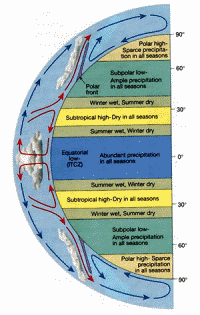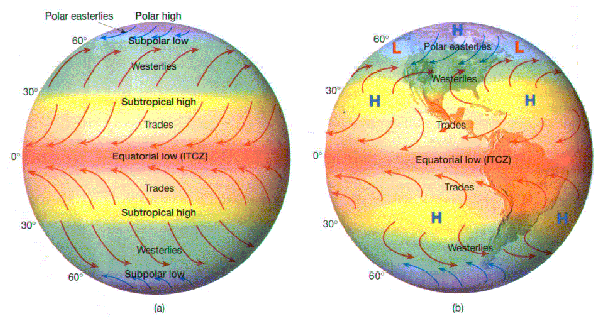|
|
 |
|
|
|
 |
| |
|
|
 |
Weather
Basics |
Global Atmospheric Circulation
The sun heats the entire Earth, but there is an uneven distribution of heat across the Earth's surface: equatorial and tropical regions receive far more solar energy than the midlatitudes and polar regions.
|
|
|
|
|
 |
The radiation received by the tropics is more than they can emit, while the polar regions emit more radiation than they receive. If there were no heat transferred between the tropics and the polar regions, the tropics would get hotter and hotter, while the poles would get colder and colder. This latitudinal heat imbalance is what drives the circulation of the atmosphere and oceans: the heat energy is redistributed from warmer to colder areas by means of atmospheric air circulation (60%) and ocean currencts (40%).
|
 |
 |
 |
|
1. Planet Earth from Space
|
|
|
Atmospheric Circulation
One way to accomplish the transfer of heat from the equator to the poles would be to have a single circulation cell that was upward in the tropics, poleward aloft, downward at the poles, and equatorward at the surface. This is the single-cell circulation model first proposed by Hadley in the 1700’s.
|
2. The global circulation would be simple (and the weather boring) if the Earth did not rotate and the Earth axis would not be tilted relative to the orbit around the sun.
Since the earth rotates, the axis is tilted, and there is more land mass in the northern hemisphere than in the southern hemisphere, the actual global pattern is much more complicated. Instead of a single-cell circulation the global circulation model consists of three cells for both N and S hemispheres. These three cells are the tropical cell (also called a Hadley cell), the midlatitude cell and the polar cell.
|
1. Tropical cell (Hadley cell) - Low latitude air movement toward the equator with heating, rises vertically, with poleward movement in the upper atmosphere. This forms a convection cell that dominates tropical and sub-tropical climates.
2. Midlatitude cell (Ferrel cell) - A mid-latitude mean atmospheric circulation cell for weather named by Ferrel in the 19th century. In this cell the air flows poleward and eastward near the surface and equatorward and westward at higher levels.
3. Polar cell - Air rises, diverges, and travels toward the poles. Once over the poles, the air sinks, forming the polar highs. At the surface air diverges outward from the polar highs. Surface winds in the polar cell are easterly (polar easterlies).
This three cell model is effective for initial description, but it is still over simplified. However it provides a good starting point to describe the main features.
|
Surface Features of the Global Atmospheric Circulation System
Main wind belts:
Because the Coriolis force act to the right of the flow (in the Northern Hemisphere), the flow around the 3-cells is deflected. This gives rise to the three main wind belts in each hemisphere at the surface:
· The easterly trade winds in the tropics
· The prevailing westerlies
· The polar easterlies
Doldrums, ITCZ:
The doldrums are the region near the equator where the trade winds from each hemisphere meet. This is also where you find the intertropical convergence zone (ITCZ). It is characterized by hot, humid weather with light winds, major tropical rain forests found in this zone. Migrates north in January and south in July.
Horse latitudes:
The horse latitudes are the region between the trade winds and the prevailing westerlies. In this region the winds are often light or calm, and were so-named because ships would often half to throw their horses overboard due to lack of feed and water.
Polar font:
The polar front lies between the polar easterlies and the prevailing westerlies.
|
 |
 |
 |
|
6. Global Circulation
Please click ont the graphic for higher resolution! (70K)
Source: NASA
|
|
Pressure belts:
The three-cell circulation model would have associated with it the following pressure belts:
· Equatorial low – A belt of low pressure associated with the rising air in the ITCZ. (The rising of warm air heated at the Equator causes an area of low pressure called Equatorial Low. As the air rises, creates clouds and precipitation.)
· Subtropical high – A belt of high pressure associated with the sinking air of the horse latitudes. (At the subtropics the air cools and descends creating areas of high pressure with clear skies and little precipitation, called the Subtropical High. The descending air is warm and dry, and produces deserts in these regions.)
· Subpolar low – A belt of low pressure associated with the polar front.
· Polar high – A high pressure associated with the cold, dense air of the polar regions.
As we have learned, the three-cell circulation model is an idealization, in reality, the winds are not steady, and the pressure belts are not continuous.
|
 |
 |
|
|
7. "Ideal" Zonal Pressure Belts
An imaginary uniform Earth with idealized zonal (continuous) pressure belts.
Please click to enlarge! |
 |
8. Actual Zonal Pressure Belts
The real Earth with disruptions of the zonal pattern by large landmasses.There disruptions break up pressure zones into semipermanent high and low pressure belts. |
|
There are three main reasons for this:
· The surface of the earth is not uniform, or smooth. There is uneven heating due to land/water contrasts.
· The wind flow itself can become unstable and generate “eddies.”
· The sun doesn’t remain over the equator, but moves from 23.5N to 23.5S and back over the course of a year.
Instead, there are semi-permanent high- and low-pressure systems. They are semi-permanent because they vary in strength or position throughout the year.
Wintertime
· Polar highs over Siberia and Canada
· Pacific High and Azores High (parts of the subtropical high pressure system) Aleutian Low and Icelandic Low
Summertime
· The Azores high migrates westward and intensifies to become the Bermuda High
· Pacific high also moves westward and intensifies
· Polar highs are replaced by low pressure
· Heat low forms over southern Asia
About this page:
Compiled by Vera Schlanger – Hungarian Meteorological Service
Scientific reviewing: Dr. Ildikó Dobi Wantuch / Dr. Elena Kalmár - Hungarian Meteorological Service, Budapest
Last updated: 2004-02-12
Further reading:
http://snowball.millersville.edu/
http://www.tesag.jcu.edu.au/
http://bss.sfsu.edu:224/
http://www.auf.asn.au/meteorology/
|
|
 |
|









